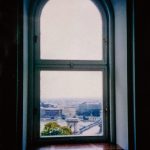I N V I S I B L E N A T U R E, Ludwig Museum, Budapest, Hungary, 1993
Director: Katerin Nery
Organization: Ludwig Museum, Budapest, Hungary, The Japan Foundation
In cooperation with: Ministry of Culture of the Czech Republic, Japanese Embassy of the Czech Republic and Hungary, Nanjo and Associates, Carosso International
sandbags, barbed wire, hourglass
13 x 12 x 9’ / 400 x 350 x 270 cm
The entire floor of the museum was covered with sandbags and a triumphal arch was constructed of jute bags whose form resembled the historic Chain Bridge of Budapest. Tangled barbed wire barriers were stacked on both sides, forcing viewers to walk through the arch. This structure was sited in such a way that the real Chain Bridge became visible as one passed through the arch. Finally, a large hourglass was placed opposite the arch.
The concept for this work developed in relation to Hungary’s contribution to the ending of the Cold War. Hungary was the first country to take down its barbed wire barriers and open its borders to Eastern Europeans fleeing to the West. The installation addresses the historical significance of Hungary’s role by creating a symbolic gateway to freedom.



